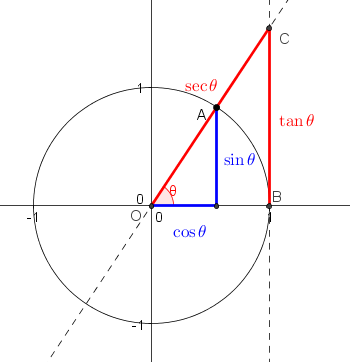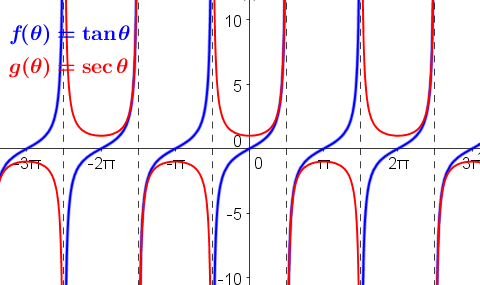In my post Trigonometry Yoga, I discussed how defining sine and cosine as lengths of segments in a unit circle helps develop intuition for these functions.
I learned the circle definitions of sine and cosine in my junior year of high school, in the class that would now be called pre-calculus (it was called “Trig Senior Math”). Two years earlier, I’d learned the triangle definitions of sine, cosine, and tangent in geometry class. I don’t remember any of my teachers ever mentioning a circle definition of the tangent function.
The geometric definition of the tangent function, which predates the triangle definition, is the length of a segment tangent to the unit circle. The tangent really is a tangent! Just as for sine and cosine, this one-variable definition helps develop intuition. Here is the definition, followed by an applet to help you get a feel for it:
Let OA be a radius of the unit circle, let B = (1,0), and let \( \theta =\angle BOA\). Let C be the intersection of \(\overrightarrow{OA}\) and the line x=1, i.e. the tangent to the unit circle at B. Then \(\tan \theta\) is the y-coordinate of C, i.e. the signed length of segment BC.
Move the blue point below; the tangent is the length of the red segment. (If a label is getting in the way, right click and toggle “show label” from the menu).
The circle definition of the tangent function leads to geometric illustrations of many standard properties and identities. (If this were my class, I would stop here and tell you to explore on your own and with others).
Some things to notice:
\(\left| \tan \theta \right|\) gets big as \(\theta\) approaches \(\pm 90{}^\circ \).
\(\tan (\pm 90{}^\circ)\) is undefined, because at these angles, \(\overline{OA}\) is parallel to x=1, so the two lines don’t intersect, and point C doesn’t exist.
\(\tan 90{}^\circ\) tends toward \(+\infty\), \(\tan (-90{}^\circ)\) tends toward \(-\infty\).
\(\tan \theta\) is positive in the first and third quadrants, negative in the second and fourth quadrants.
\(\tan \theta\)=\(tan (\theta+180{}^\circ)\) — the angles \(\theta\) and \(\theta +180{}^\circ\) form the same line. Thus the period of the tangent function is \(180 {}^\circ = \pi\) radians.
\(\tan \theta\) = \(- \tan (-\theta)\). Moving from \(\theta\) to \(-\theta\) reflects \(OC\) about the x-axis.
\(\tan \theta\) is equal to the slope of OA (rise = \(\tan \theta\) , run =1), which is also equal to \(\dfrac{\sin\theta}{\cos\theta}\), as well as Opposite over Adjacent for angle \(\theta\) in right triangle CBO.
\(\tan (45{}^\circ)=1\). When \(\theta=45{}^\circ\), triangle CBO is a 45-45-90 triangle, and OB=1. Similarly, \(\tan (-45{}^\circ)=-1\), etc.
For small values of \(\theta\), \(\tan \theta\) is close to \(\sin \theta\), which is close to the arc length of AB, i.e. the measure of \(\theta\) in radians.
If we define \(\arctan \theta\) as the function whose input is the signed length of BC and whose output is the angle \(\theta\) corresponding to that tangent length, then the domain of that function is the reals, and it makes sense to define the range as \(-90 {}^\circ< \theta <90{}^\circ\) (in radians \(-\pi/2<\theta < \pi/2\) and arctan’s output is an arc length). This range includes all the angles we need and avoids the discontinuity at \(\theta= \pm 90{}^\circ =\pm \pi/2\) radians. For \(\left| \theta \right|\leq 45{}^\circ\), \(\left| \tan \theta \right|\leq 1\). Half of the input values of \(\tan \theta\) give outputs with absolute values less than or equal to 1, and the other half give values on the rest of the number line. This mapping also occurs with fractions and slopes, but there’s something very compelling about seeing the lengths change dynamically. Applets like the one above could also help students develop intuition about slopes. \(\tan (180{}^\circ-\theta) = -\tan \theta\). We reflect BC over the x-axis to form \(B{C}’\). Then \(\angle BO{C}’=\theta\) and \(\angle BOD =(180{}^\circ-\theta)\). \(B{C}’\) (the blue segment) is the tangent of \((180{}^\circ-\theta)\). 
\(\tan (\theta \pm 90{}^\circ)\) = \(-1/\tan \theta\). The picture below illustrates the geometry of this identity when \(\theta\) is in the first quadrant.
The line formed at \(\theta + 90{}^\circ\) is perpendicular to OC and \(\triangle COB\sim \triangle ODB\). Thus \(\dfrac{BD}{OB}=\dfrac{OB}{BC}\), and with appropriate signs, \(\tan (\theta + 90{}^\circ)\) = \(-1/\tan \theta\). Since \(\tan \theta\)=\(\tan (\theta+180{}^\circ)\), \(\tan (\theta +90{}^\circ)=\tan(\theta-90{}^\circ)\).
The applet below shows the geometry in all quadrants, and it gives a dynamic sense of the relationship between \(\tan\theta\) and \(\tan(-\theta)\). Again, move the blue point:
Special Bonus: The Secant Function
The signed length of the segment OC is called the secant function, \(\sec\theta\).
Using similar triangles, we see that \(\sec \theta = \dfrac{1}{\cos \theta}\).
The Pythagorean Theorem applied to \(\triangle COB\) shows that \(\tan^2\theta+1=\sec^2 \theta\).
When the tangent function is big, so is the secant function, and when the tangent function is small, so is the secant function. Also \(\sec \theta\) is close to \(\pm 1\) when \(\theta\) is close to the x-axis and when \(\tan \theta\) is close to 0.
The graphs of the two functions look nice together:



Michael Enright
I was doing something today with a student and it dawned on me that the tangent was called that because it really was a tangent but I couldn’t remember why. When I got home I started to Google it but it still took me quite a while before I ran into your explanation. Thank you very much.
dborkovitz
Thanks, Michael. It was fun working through all these properties of the tangent myself; glad you found the post helpful. (Sorry for the late response, I lost all comments on my website, just reconstructing now).
Matt
Regarding the section above on the Secant Function:
Why doesn’t the graph of the secant look very similar to the graph of the tangent?
If Point C only moves in the vertical direction, then it looks like secant would follow the values of the length of the tangent since secant and tangent are both legs of the same triangle. How can the length of secant approach negative infinity as the lenght of tangent approached positive infinity?
From what I can tell, the “normal” graphs of the tangent function work if tangent is defined as it is above. However, it looks like the “normal” graphs of secant only work is the tangent is defined at Point A and the secant is the length from the origin to the intersection of the tangent line and the positive x-axis.
dborkovitz
Matt, you raise an interesting point. Sorry this note is months late, no idea if you’re following (had some health issues last semester that kept me off my site). I think the issue is how the sign of secant is determined, and it’s determined the same as the sign of cosine, based on the x coordinate, whereas the sign of tangent is based on the slope of the line from the origin.
The graphs of secant and tangent do follow closely in the first and third quadrants, where their signs are equal.
Choosing the sign of the secant seems to follow from using 1/cos as the definition, not from using its relationship to the geometric definition of a tangent. It would be interesting to learn more about the history of the definition of the secant function; at this moment, I don’t know much …
Thanks for raising something I didn’t notice ….
Jirka
That’s a great picture you got there. It shows nicely how the tangent is rather length expressed as ratio through similarity between the two triangles. A lot can be deduced from that. At least a lot more than from just opposite/adjacent formula. Thanks a lot!
Owen Prince
If you plot tangent point one you will find that it is tangent to the circle and intersects: the unit circle, the triangle and the hypotenuse. Where these three intersec is tangent point one. I have a chart on it that I made that shows this very well , therefore the tangent point is a tangent point on the unit circle.
Nour
Very cool article
Finn
Very nice website! I loved all of the interactive sections and the pictures that gave great mathematical representation. Keep it up!
dborkovitz
Thanks!
Adam
Most helpful and simple explanation of tangent functions that I’ve seen. Thanks. 🙂
dborkovitz
Thanks, Adam.
Robert R.
Thank you. I had to go through a dozen websites before I found yours. I was trying to see how the tangent is negative in quadrant two with a visual demonstration. The other sites all gave algebraic/arithmetical reasons (which were already obvious to me); yours was the only one that provided the geometric demonstration I was seeking. Very nice.
dborkovitz
Thanks, Robert.